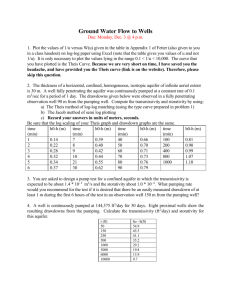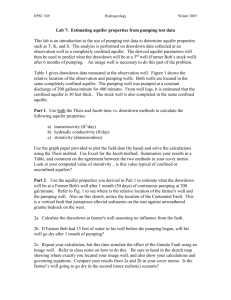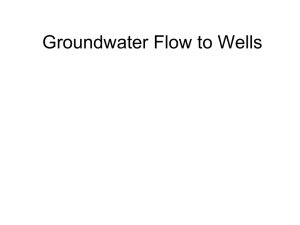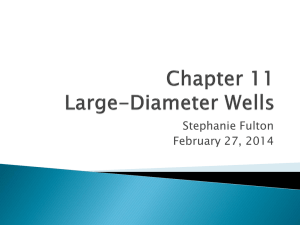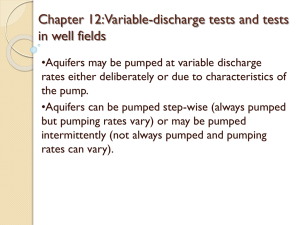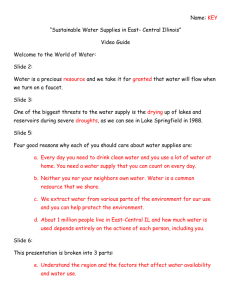Evaluation of Aquifer Characteristics for Selected New
advertisement
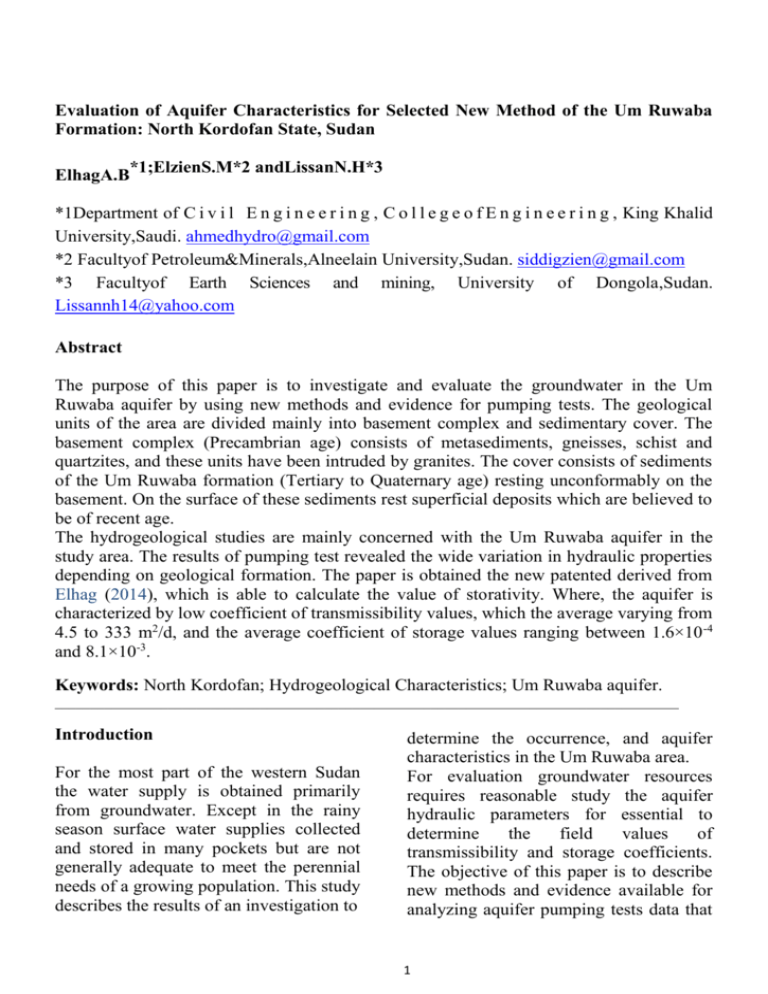
Evaluation of Aquifer Characteristics for Selected New Method of the Um Ruwaba Formation: North Kordofan State, Sudan ElhagA.B*1;ElzienS.M*2 andLissanN.H*3 *1Department of C i v i l E n g i n e e r i n g , C o l l e g e o f E n g i n e e r i n g , King Khalid University,Saudi. ahmedhydro@gmail.com *2 Facultyof Petroleum&Minerals,Alneelain University,Sudan. siddigzien@gmail.com *3 Facultyof Earth Sciences and mining, University of Dongola,Sudan. Lissannh14@yahoo.com Abstract The purpose of this paper is to investigate and evaluate the groundwater in the Um Ruwaba aquifer by using new methods and evidence for pumping tests. The geological units of the area are divided mainly into basement complex and sedimentary cover. The basement complex (Precambrian age) consists of metasediments, gneisses, schist and quartzites, and these units have been intruded by granites. The cover consists of sediments of the Um Ruwaba formation (Tertiary to Quaternary age) resting unconformably on the basement. On the surface of these sediments rest superficial deposits which are believed to be of recent age. The hydrogeological studies are mainly concerned with the Um Ruwaba aquifer in the study area. The results of pumping test revealed the wide variation in hydraulic properties depending on geological formation. The paper is obtained the new patented derived from Elhag (2014), which is able to calculate the value of storativity. Where, the aquifer is characterized by low coefficient of transmissibility values, which the average varying from 4.5 to 333 m2/d, and the average coefficient of storage values ranging between 1.6×10 -4 and 8.1×10-3. Keywords: North Kordofan; Hydrogeological Characteristics; Um Ruwaba aquifer. ________________________________________________________________________________________ Introduction For the most part of the western Sudan the water supply is obtained primarily from groundwater. Except in the rainy season surface water supplies collected and stored in many pockets but are not generally adequate to meet the perennial needs of a growing population. This study describes the results of an investigation to determine the occurrence, and aquifer characteristics in the Um Ruwaba area. For evaluation groundwater resources requires reasonable study the aquifer hydraulic parameters for essential to determine the field values of transmissibility and storage coefficients. The objective of this paper is to describe new methods and evidence available for analyzing aquifer pumping tests data that 1 were patented by Elhag (2014), which for use the new simple procedures that are adaptable to the solution of practical problems. Therefore, the average aquifer parameter estimates are in good agreement with the results obtained using other methods. Material and methods The area of study is located between the longitudes 30º 37´ and 31º 54´ E and latitudes 12º 42´and 13º 30´, and the area of study covers about 12328 km2. The study area includes many different geology settings. The rock formations that underlie the area according to Elhag (2003) include a basement complex of Precambrian age, the Umm Ruwaba fluvial and lacustrine series of Pliocene to Pleistocene age, and the superficial deposits of Quaternary age. Because of the hydrogeological data from well dug into the sedimentary rocks. The distribution of the basement and sedimentary rock units is shown in (Fig.1). The basement rock is outcropped around the study area in El Obeid and south of El Rahad, its constitutes mostly of the oldest rocks in the region which including; granite, gneiss, schist, quartzite and other igneous and metamorphic rocks. Since the emplacement of these rocks they have been subjected to prolonged periods of erosion end structural deformation. Sedimentary rocks are two formations in the study area. The first one is called Umm Ruwaba formation. Elhag (2003) found in water wells around the Umm Ruwaba town with a thickness around 700 feet. That it consists of sand, clay and a few gravel overlying the basement complex. The last formation is superficial deposit and sand dunes which cover most all the area see. Ishag (1965) Announced that the after end of Cretaceous times there was a period of erosion and nondeposition, during which the Nubian rocks were completely removed from parts of the Province. This erosional gap continued until middle Pleistocene time, when the Umm Ruwaba Series was deposited. The series occupies large areas in the east and southwest parts of the Province. The Umm Ruwaba series are lacustrine and fluvial deposits, during the Pliocene to Pleistocene era the clastic sediments of the Umm Ruwaba formation was deposited unconformably over the Nubian Sandstone, but sometimes the Nubian may be absent and the Umm Ruwaba may directly lie on the basement complex. Outcrops of Umm Ruwaba are rare, because they are covered in most places by superficial deposits. The Umm Ruwaba strata are wide depressions which are believed to have been formed during Tertiary times, and these sediments are believed to be younger than the Nubian series, which are generally, less consolidated materials; they are composed mostly of sand, clay and gravels, and the sediments are generally, unsorted. The bedding is rapid facies changes within relatively short distances are common. The Umm Ruwaba series attains a maximum thickness of 600 feet or more in this part of the country. The Umm Ruwaba series are similar to the Nubian Sandstone in many aspects, such as bedding and facies. The hydrogeologic characteristics are quite similar, groundwater being confined with a low artesian pressure; the two aquifers, the 2 Nubian and Umm Ruwaba, are hydraulically connected and may be treated as a single aquifer system. The sediments of the Umm Ruwaba formation are an important source of groundwater in the study area. Tectonic movements in east Africa, probably occurring during late Tertiary time, resulted in the formation of several structural basins in the Nubian and basement rocks, and in the extrusion of the volcanic rocks Karkanis (1966). The earliest recognized phase of tectonism in the Kordofan States is recorded in Precambrian rocks especially in the J. Damber area. This tectonism, metamorphism, and igneous activity occurred over a long period of geologic time, generating the Precambrian crystalline rocks that form the stratigraphic basement for stratified rocks throughout the region. During the Pliocene and the Pleistocene time the basins were filled with fluvial and lacustrine deposits that comprise the Umm Ruwaba formation. Finally, relatively deposits of recent age cover large areas of the older formations. These superficial deposits are continuous and are of several types. In the northern part of the area they are mainly sand dunes extent from north to south depending on wind direction; in the southern part, they occur as extensive plains of clay and silt especially in Kor Abu Habil. The synclinal structure of the basin is interrupted by uplift along the basement rocks (Fig. 1). The structural features can be distinguished from depositional features in region that was obtained by the geophysical techniques and drilling wells (Fig. 2). Fig. (1): Map Showing the Areal Distribution of Sedimentary and Basement rocks in Kordofan Province modified after Elhag (2003). 3 Fig. (2): Geologic Section A-A' West to East across Eastern Kordofan Province. Pumping well test data can be analyzed using standard Elhag analysis method, and Cooper - Jacob analysis method. A very simple method for determining the formation coefficients was introduced by Cooper and Jacob (1946). It’s a modification of the Thies non-equilibrium method. Cooper and Jacob have shown that when plotted on semi-logarithmic paper, the theoretical drawdown curve approaches a straight line when sufficient time has elapsed after pumping started. Plot Elhag "type curve" of the values W(u) and (u) in Fig. (3), which derived 𝑢² from Taylor series formula (1), and modified after Kruseman and Ridder, 1970). From the straight line determine the values for s, t and to (Fig. 4), while, Elhag formulas (2 and 3) were applied to determine W(u) and (u) for the drawdown test (Fig. 5), the procedure of this method is similarly the Chow (1952). The coefficient of transmissibility is determined from formula (4). Therefore, the coefficient of storage is computed from formulas (5 and 6) as follows: 𝑢³ 𝑊(𝑢) = (−0.5772 − ln 𝑢 + 𝑢 − 2.2! + 3.3! − ⋯) … … … … … … … … … … … … … … … . . (1) 𝑊(𝑢) 𝑠 = … … … … … … … … … … … . (2) 2.1 ∆𝑠 𝑢 𝑡° = … … … … … … … … … … . . … . . . (3) 0.8 𝑡 𝑇 𝑄 𝑊(𝑢) … … … … … … … … … … … (4) 4𝜋𝑠 𝑆 = 𝑇𝑢 … … … … … … … … … … . (5) 1.87(𝑟²/𝑡) 𝑆= 4𝑇𝑡𝑢 … … … … … … … … … … … . . (6) 𝑟2 Where Q is the discharge rate from the pumping well; T is the transmissibility of the aquifer; s is the drawdown of the water level; ∆s is the slope of line per one log cycle; W(u) is the well function; u is the value versus the value of the W(u); S is the storativity of the aquifer; t is the time since pumping started; to is the time value of the intercept of the straight line portion of the drawdown curve (extended toward the starting time) and the zero 4 drawdown line; r is the distance between the pump well and observation well. Fig. (3): Elhag type curve for W(u) versus (u) only (modified after Elhag (2014). Fig. (4): The result of drawdown pumping test using straight line. The formation coefficients T and S were determined from the recovery data collected during the aquifer test after pumping had ended. The recovery curve is obtained by plotting the amount of the water level has raised from the extrapolated drawdown against the elapsed time after pumping ended. The new graphical method described by Elhag (2014), which the first step is to plot field data for the values of residual drawdown (s′) versus the values of time since pumping stopped (t′) on logarithmic tracing paper (Fig. 5). On the another sheet of similar paper, theoretical plot Elhag's type curve W(u) along the y-axis and (u) along x-axis (Fig. 3). The data analysis is done by matching the field data to the type curve. The type curve should be consisting of a smooth curve while the recovery test data curve should consist of only the plotted individual points. Finally, in making these graphs, s′ and W(u) should be on the same axes (usually the ordinate) of their respective graphs. Consequently t′ and (u) would be on the same axes (usually the abscissa) of their respective graphs and always being careful to keep the axes parallel. When the best fit is obtained by eye, a match point is selected, at any point desired on the fitted curve and marked on both curves but the best point selected where the coordinates of the type curve are W(u) equal 100 and (u) equal 2.5x10-1Elhag (2014), and from the match point determine the values for s′ and t′ (Fig.5). The values of s′, t′, W(u), and (u) to be used in calculating hydraulic conductivity (T and S) are the values obtained from the "match-point" of the graphs. The values of T and S are computed from formulas (7 and 8) respectively in the following forms: 𝑇= 𝑄 𝑊(𝑢) … … … … … … … … … . (7) 4𝜋𝑠´ 0.3𝑇𝑢−1 𝑆= … … … … … … … … … . . (8) 4𝜋(𝑟 2 /𝑡´) Where s′ is the residual drawdown; t′ is the Elapsed time in minutes or days measured from the time pumping ended. 5 Fig. (5): plot field datafor recovery test against Elhag's type curve. Result The aquifer test data was selected for confined aquifer parameter estimation by new methods editing. The data was analyzed by Elhag's methods (2014). The results of parameter estimation for aquifer data are presented in Table (1), drawdown pumping test which found that transmissibility range from 5.7 to 288m2/d and storativity reach about 1.1x10-4 and 8.9x10-3 by the straight line procedure. The recovery values of the parameter estimation using Elhag's method also by the type curve matching procedure give transmissibility 3.3 to 210m2/d and storativity 2.0x10-4 to 7.2x10-3 respectively. Table (1): The results of the pumping test obtained from Umm Ruwaba formation. Borehole Drawdown Recovery Average 2 2 2 T (m /d) S T (m /d) S T (m /d) S -4 -4 El Dibeiba 24 1.1x10 21 2.0x10 22.5 1.6x10-4 Um Ushara 288.3 4.1x10-4 209.7 4.7x10-4 249 4.4x10-4 Um Gerif 32 8.9x10-3 24 7.2x10-3 28 8.1x10-3 El Sweima 311 1.3x10-3 355 3.7x10-4 333 8.4x10-4 Um Debos 5.7 2.5x10-4 3.3 5.6x10-4 4.5 4.1x10-4 Discussion Identification and characterization of the main different types of groundwater aquifer systems will thus help greatly to develop the existing groundwater potential of the target area. The straight line slope and type curve matching has been developed to determine the aquifer characteristics from aquifer test data. This study has quantified the hydraulic properties of Umm Ruwaba formation including transmissibility and storativity. Analysis results of raw pumping test data from a data set of boreholes show that the maximum and minimum transmissibility values obtained and indicate the heterogeneity of the aquifer materials as indicated by their variation in the values of transmissibility. References Elhag, A. B (2014). New methods of analysis and evaluation of pumping tests data for groundwater wells. First edition, 20 – 35 pp. Elhag, A.B (2003). Hydrogeological investigation in sedimentary aquifers, El Bazza area in North Kordofan State. A thesis submitted 6 to the Graduate College in fulfillment of the requirements for the master degree of Science in Hydrogeology. Department of Geology Faculty of Science, Kordofan University, Sudan. Kruseman, G.P. and De Ridder, N.A. (1970). Analysis and evaluation of pumping test data, Intl. for land reclamation and improvement, Bulletin 11, Wageningen. Chow, V.T. (1952). On the determination of transmissivity and storage coefficient from pumping test data. Am. Geophys. Union Trans., V. 33, pp, 400-401. Cooper, H. H and Jacob, C. E (1946). A Generalized graphical method for evaluating formation constant and summarizing well-field history. Trans. AM. Geophys. Union v. 27(4). Ishag, A.H (1965). A quantitative study of the potential recharge to principal aquifers in Kordofan Province of Western Sudan A thesis submitted to the faculty of the department of geology in partial fulfillment of the requirements for the degree of Master of Science In the graduate college the unversity of Arizona. Karkanis, B.G (1966). Hydrochemicalfacies of groundwater in the a thesis submitted to the faculty of the department of geology in partial fulfillment of the requirements for the degree of master of science in the graduate college the uiversity of Arizona Western Provinces of Sudan. 7
